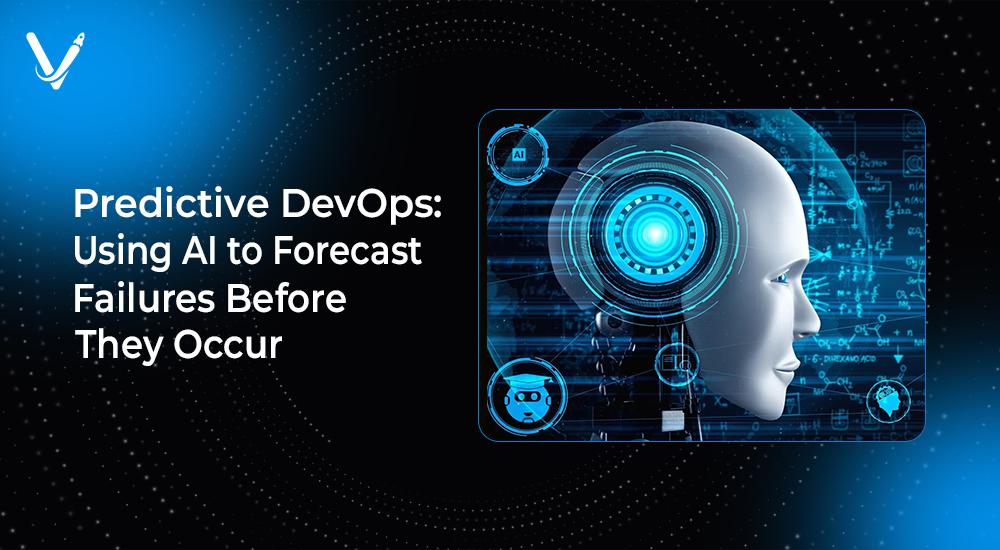Predictive DevOps: Using AI to Forecast Failures Before They Occur


- Oct 1, 2025



Every business that builds and delivers software faces one recurring challenge: failures that disrupt systems, impact customer experiences, and increase costs. The traditional DevOps approach has always been about faster deployment, improved collaboration, and more automation, yet even the best pipelines can still fail when unexpected issues appear. What if there was a way to predict failures before they happen and prevent them entirely? This is where predictive DevOps powered by Artificial Intelligence is transforming the software development landscape.
Predictive DevOps is more than just another buzzword. It represents a shift in how development and operations teams can anticipate problems by applying machine learning, predictive analytics, and anomaly detection. By turning reactive firefighting into proactive prevention, predictive DevOps empowers organizations to run more resilient pipelines, minimize downtime, and deliver seamless customer experiences. In this article, we’ll explore the concept of predictive DevOps, how AI is integrated into workflows, the technologies behind it, real-world use cases, challenges, and best practices for implementing it successfully.
DevOps began as a cultural and technical movement designed to break silos between development and operations teams. Over time, it evolved into a set of practices that promote automation, continuous integration, and rapid deployment. As systems became more complex with cloud-native applications, microservices, and distributed architectures, the challenges of monitoring and maintaining stability also multiplied.
Traditional monitoring tools and log analysis platforms offer insights after problems occur. Teams often scramble to find root causes only after downtime or performance degradation impacts users. In fast-paced digital ecosystems, being reactive is no longer enough. The rise of predictive intelligence powered by AI offers a new paradigm. By learning from historical data and identifying subtle signals that humans might miss, predictive DevOps can forecast failures long before they disrupt production systems.
Predictive DevOps combines artificial intelligence, machine learning, and statistical models with DevOps workflows to forecast possible issues. Instead of waiting for alerts after an error occurs, predictive systems proactively identify anomalies, bottlenecks, or resource exhaustion patterns.
Think of predictive DevOps as a weather forecast for your software ecosystem. Just like meteorologists predict storms based on climate models and satellite data, AI models in DevOps use logs, metrics, and infrastructure telemetry to estimate where potential failures may emerge. The end goal is not only to detect but also to prevent disruptions by automating corrective actions before users ever notice an issue.
Key elements of predictive DevOps include anomaly detection, predictive maintenance, intelligent alerting, failure pattern recognition, and automated remediation. Together, these capabilities allow teams to work smarter instead of harder, reducing firefighting and enabling innovation.
Artificial Intelligence brings predictive capabilities to DevOps by leveraging multiple techniques:
By embedding AI models directly into CI/CD pipelines, teams can automatically halt risky deployments, reroute traffic, or scale infrastructure before a critical failure occurs.
Adopting predictive intelligence within DevOps brings several strategic benefits to enterprises:
The biggest advantage lies in shifting the mindset from reactive incident response to proactive prevention.
Predictive DevOps is already shaping multiple industries. Some notable applications include:
These examples highlight the versatility of predictive DevOps across sectors where reliability is mission-critical.
While promising, predictive DevOps does come with challenges that organizations must address.
Overcoming these challenges involves combining technical readiness with organizational commitment to data-driven transformation.
To succeed with predictive DevOps, organizations can follow several best practices:
By taking an incremental and collaborative approach, predictive DevOps adoption becomes more manageable and impactful.
Modern cloud-native architectures—built on microservices, Kubernetes, and serverless computing—are dynamic, distributed, and complex. Traditional monitoring often struggles in such environments because the scale and velocity of change exceed human capacity to manage. Predictive DevOps fills this gap by using AI to monitor container health, detect anomalies across distributed nodes, and predict failures in ephemeral resources.
For instance, AI can analyze Kubernetes pod restarts, latency trends, and resource consumption patterns to recommend scaling strategies before workloads fail. In serverless environments, predictive DevOps helps anticipate execution bottlenecks or cost overruns. This makes predictive intelligence a natural fit for modern DevOps environments.
As AI technologies advance, predictive DevOps will continue to evolve. Future trends include:
These trends highlight a future where predictive DevOps becomes central to enterprise resilience and agility.
Enterprises depend on uninterrupted digital services for revenue, brand reputation, and customer satisfaction. The cost of downtime is staggering, often running into millions per hour for critical systems. Predictive DevOps directly addresses this challenge by reducing failures and maximizing uptime.
For businesses adopting AI-driven DevOps, the payoff extends beyond technical benefits. It also creates competitive differentiation, as organizations that deliver consistent, reliable, and seamless experiences build stronger customer trust. In a marketplace where digital disruptions can make or break reputations, predictive DevOps is rapidly becoming an essential capability.
Predictive DevOps is not just an enhancement of existing practices but a transformation of how enterprises approach software reliability. By applying artificial intelligence and machine learning, teams can forecast failures, automate remediation, and reduce costly downtime. It represents a shift from reactive problem-solving to proactive prevention, enabling organizations to focus on innovation and growth.
At Vasundhara Infotech, we believe predictive intelligence is the future of DevOps. By helping enterprises integrate AI into their workflows, we empower them to run resilient, cost-effective, and user-centric systems. If your organization is looking to adopt predictive DevOps and achieve next-level reliability, our experts are ready to guide you through every step of the journey. Let’s work together to build the future of intelligent operations.
The key benefits include reduced downtime, improved user experiences, cost savings, smarter resource allocation, and stronger security.
Copyright © 2025 Vasundhara Infotech. All Rights Reserved.